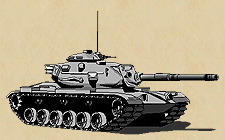Quaker principles founded Guilford College. As a Quaker institution, Guilford has struggled with reactions to war.According to our website, Guilford “draws on Quaker and liberal arts traditions to prepare men and women for a lifetime of learning, work, and constructive action dedicated to the betterment of the world.”
Our college attempts to supply “a global perspective that values people of other cultures and the natural environment in which we all live,” and “a values-rich education that explores the ethical dimension of knowledge and promotes honesty, compassion, integrity, courage, and respect for the individual.” However, how do these ideals apply in a time of warfare?
Revolutionary War: Get to know your enemies.
Many historical events happened on what is now the Guilford campus. During the American Revolution, the Battle of Guilford Courthouse occurred only four miles away, and there was also a skirmish across the street.
Friends from the New Garden Meeting cared for the wounded on both sides, and buried the dead in graves besides their enemies, which can still be seen in the graveyard across the street.
Civil War: There was nothing civil about it.
We live on historical grounds from the times of the War Between the States. During the Civil War, Guilford was not officially a college, but instead operated as a co-ed boarding school.
The school remained open throughout the war with help in part from Northern funding. Southern and northern young men attended the school at the time. Guilford kept their male students protected from being claimed for battle, and despite military threats, did not force their students to join the war for either side.
World War I: Where have all the college men gone?
The college was young when the First World War affected America. Since Guilford was still small, both the student population and the financial basis of the college was hard hit by the war and the Great Depression.
Alexander Stoesen remarks in his book Guilford College on the Strength of 150 years, “The decline in enrollment was inevitable . although less than a third of the student body belonged to the Society of Friends, the principles of peace inculcated for many years were strong. There was sure to be an undercurrent of disapproval when men volunteered.. Sooner or later a number of boys did go fight in France or to serve abroad with the American Friends Reconstruction Units.”
Despite preferences for peace, the number of men on campus decreased extremely. Dorothy Lloyd Gilbert, a Guilford historian and board member remarks in her book Guilford: A Quaker College, “During war time, the men students, although they were not so numerous as usual, were especially active.”
Joking examples showed popular belief about the enemy in print. In the 1914 Quaker, the Senior Last Wills included a sly reference to the validity given to German writings: “We give and bequeath to the Biology department all the latest German books on the present war and its effect on the evolution of the race.”
The college was restructured after the war in 1918. New and returning faculty were gathered together from those who had gone into battle or taken leave. Enrollment dropped after WWI, and Guilford almost reverted to only a preparatory school. However, the college kept itself together through difficult financial times and continued as Guilford College.
World War II: Conflicts, Complications, Columns, and Conscientious Objectors.
Guilford College was greatly changed by America’s inclusion in World War II.
In the summer of 1941, Guilford hosted training for conscientious objectors. Both before and after the war, Guilford helped to sponsor non-violent alternatives for required war service.
Recruits diminished Guilford’s faculty, staff, and students. Stoesen remarks, “In March of 1943, reserve members were suddenly called to active duty, and the number of men on campus dropped from 157 to 61 and hit a low of 59 the next year.”
Many of the faculty could join the service if they so desired. Guilford did not attempt to “dictate people or their beliefs,” explains Max Carter, Director of the Friends Center and Campus Ministry Coordinator. About 75 % of young Quakers nationally served in some capacity, and ” at Guilford it would have been about the same,” Carter said.
Throughout the war, the government pressed to have ROTC training on campus, but the college would not allow it. Other Quaker colleges allowed the government to make use of campus space for training. Stoesen remarks, “even if the College should founder, [the trustees] would never permit [the campus’] use by the military.”
In 1942, Guilford’s campus came its closest to military training. “Most of the military training facilities in the United States were filled to capacity, so the armed forces decided for all of those in the higher intelligence brackets to enroll in colleges rather than wait at home for their call to induction . about 30 of these students came to Guilford College,” explains Stoesen.
For the only time in Guilford College history, there were “marching Students” on campus. Pictures of their lines and practice out on the field next to New Garden can be seen in the 1942 Quaker.
The faculty who were involved in the war sent back personal stories, reflections, and advice to students. Lt. E. Daryl Kent, a religion professor, wrote prolific letters to The Guilfordian.
During WWII, nine male Japanese-Americans from American internment camps played basketball for Guilford due to Clyde Milner. Milner brought the students to college from the camps. Carter remarks that he was “despised and ridiculed by Greensboro for it.” Milner’s actions were controversial to say the least. At the time, there were not even African Americans at Guilford.

